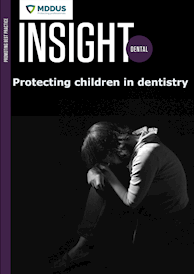WHEN it comes to safeguarding children, dental teams often don’t see themselves as an important part of the process – but you are. You may never get a “thank you”, but you can potentially save lives, improve health outcomes and decrease the burden on the health service, all by raising your concerns and helping to identify child abuse and neglect.
One key piece of advice I like to give to teams is to think about safeguarding processes now – don’t wait until you come across a case and panic. And please be reassured that you do not need to be an expert to be involved in safeguarding (indeed, it was a taxi driver who took Victoria Climbié to hospital at the end of her short life despite numerous medical and social services being involved in her case). This is true for any member of the dental profession.
Real-life examples
I have had the honour and privilege of being involved with and hearing about numerous cases where dental teams played a crucial safeguarding role. A few examples include:
- A dentist identifying missing primary incisors in a young child that was found to be due to assault, plus an offence of wilful neglect for the carers not seeking timely care.
- A dentist identifying ongoing dental problems in a case known to social work, but where it was thought that everything was okay. By raising their concerns, the dentist brought the case back to the attention of social work resulting in further investigations.
- A dental team raising concerns about a child not being brought to dental appointments which resulted in close working with the health visitor, support for the child and family and identification of social, health and developmental needs of the child that were previously not being met.
Follow your instincts
As dental professionals of every kind we have a wealth of experience working with people and families. We are good at talking to patients and their families and we are good at observing and recording. We know what “normal” parent/child interactions look like and this innate knowledge means we also get that gut instinct when something does not look, sound, or feel right.
If you have concerns, don’t let someone tell you they are not valid. There are examples of this throughout reviews of significant cases where concerns raised were dismissed by those who seemed to know better or have more experience.
I've been researching the role of dental teams in child safeguarding for over 14 years. Sometimes I can reassure dental teams about their concerns but often I agree that there is something to be concerned about. It can help your confidence to speak to someone with more experience than you in safeguarding, whether that is a dental colleague, a paediatric dental consultant or a member of your local child protection or child safeguarding team.
Practical steps
Here are some simple, practical things you can do:
Discuss with the whole team. Know your local policies and procedures on how to raise concerns about child safeguarding. Be sure to discuss this in your team so you all know what your roles and responsibilities will be if someone has a concern. Teamwork is important so that we all feel supported when we are dealing with unfamiliar or uncomfortable situations. Include time for discussion of safeguarding at practice meetings and have regular training, and case discussions regarding it. The British Dental Association (BDA) has an excellent Safeguarding Children in Dental Practice: a checklist (PDF) that is free to download from their website.
Be alert for signs or symptoms of abuse and neglect. There is no pathognomonic injury from child abuse of the face and mouth but be alert for “tattoo” injuries which mimic the shape of whatever has caused them – for example, slap marks, grip marks, impressions of rings, cords or belts.
Key questions. Whenever you see any facial or oral injury ask yourself:
- Could the injury have been caused accidentally and if so, how?
- Does the explanation for the injury fit the age and the clinical findings?
- If the explanation is consistent with the injury, is this itself within normally acceptable limits of behaviour?
- If there has been delay in seeking advice, are there good reasons for this?
Be prepared. Know how to respond to concerns regarding dental neglect and follow the three-stage process outlined on the BDA’s Child Protection and the Dental Team website.
Know where to go for help and advice:
- Experienced colleague
- Named safeguarding nurse
- Child protection adviser
- Named doctor for safeguarding
- Social work/social services (e.g. social care direct)
- Children’s services department (e.g. First Contact)
- NSPCC helpline 0808 800 5000.
Know what to do if you still have concerns following initial discussion.
Know how to refer/share your concerns. This is usually by telephone initially, followed up in writing (for example, completion of a notification of concern form). Include the relevant facts and a statement of concerns.)
Common pitfalls
The common areas where safeguarding falls down are:
- poor assessment processes
- failure to record adequately
- failure to share information
- ineffective decision making and a lack of inter-agency working.
Take action
Absolutely no one wants to be the last professional who sees a child before they come to harm, so share your concerns and know who to share them with and how to do it. Put yourself in the child’s shoes and imagine what that child may think in the future when they have enough understanding to process what they have been through. What do you want that thought to be? “I went to that dental practice, and they knew things weren’t right and they helped me” or “I went to that dental practice, and they knew things weren’t right and they did nothing”?
You can make a difference.
This page was correct at the time of publication. Any guidance is intended as general guidance for members only. If you are a member and need specific advice relating to your own circumstances, please contact one of our advisers.
Read more from this issue of Insight Dental

Save this article
Save this article to a list of favourite articles which members can access in their account.
Save to library
